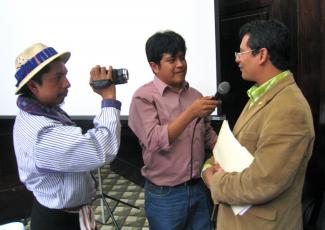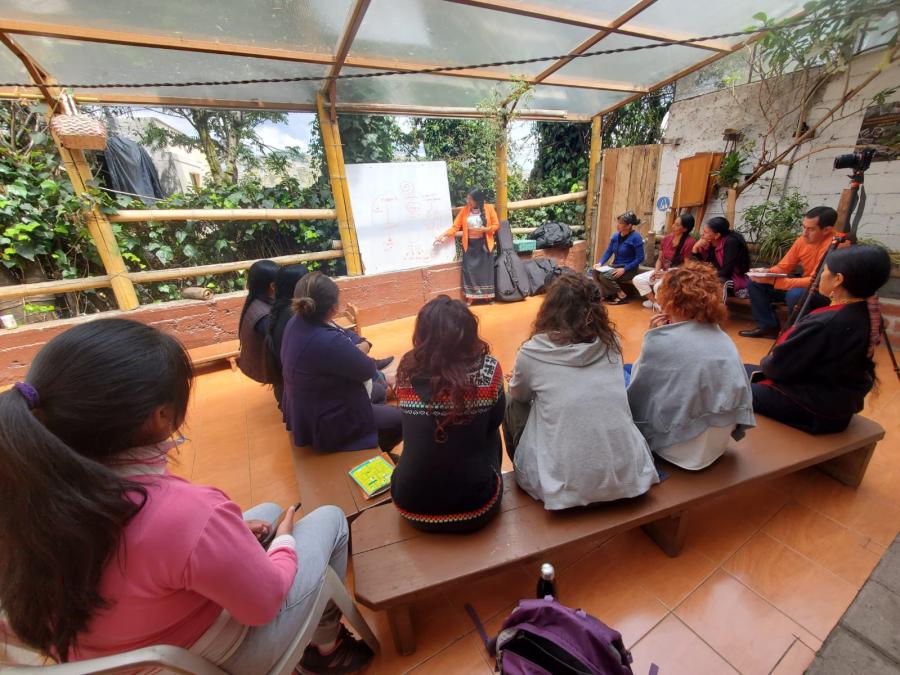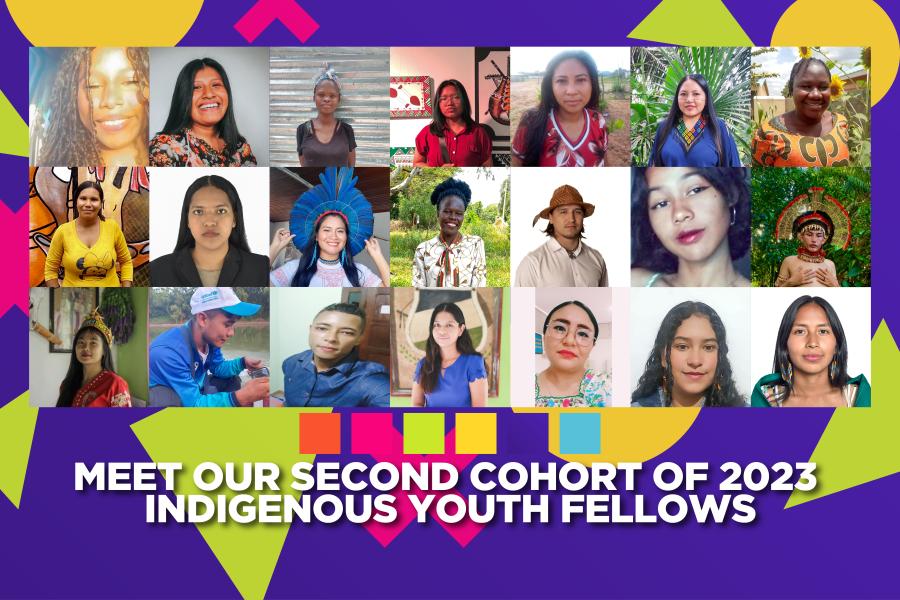
“Our language is the number one source of our soul, our pride, our being, our strength, and our identity.”— Indigenous language instructor, Cultural Survival Quarterly, 2010
Daniel Gomez is a farmer and carpenter who lives in Palín, Escuintla, a Poqomam Maya town in Guatemala and a virtual island in the sea of Spanish-speaking cities and towns that comprise the Guatemala City metro area. Gomez and his wife raised their children to be bilingual speakers of Poqomam and Spanish. They worked hard to ensure that their children (including Cultural Survival staff member Cesar Gomez) all received a university education, while at the same time remaining deeply rooted in Poqomam culture.
Gomez was concerned that the Poqomam language and traditions were slipping away, subsumed by the waves of Spanish language and culture that washed over the people in the form of radio and television from nearby Guatemala City, coupled with the schools’ monolingual Spanish education system. In an attempt to stem the tide, Gomez, together with other citizens of Palín, established two community-based institutions: a bilingual school that gave equal weight to Poqomam and Spanish, and a radio station that did the same. The idea was simple: students would become bilingual in the classroom, and their bilingualism would be reinforced on the local airwaves. The success of Gomez’s story is one of many inspiring examples of a grassroots effort to reverse the trend of an Indigenous community’s language loss.
Language Decline: A Global Phenomenon
According to many linguists, half of the world’s 6,000–7,000 languages will be gone in the next century, and Indigenous languages are at the forefront of those going silent. Of the original 300 tribal languages spoken in North America, just 175 remained in 1997. Of these, 125 were spoken by very few, mostly elders, and 55 were spoken by 1 to 6 people (Indigenous Language Institute).
When a language goes silent, we lose more than just a grammatical system or a vocabulary. Each language represents a unique worldview or cosmology. Languages embed knowledge about cultural values, spiritual practices, and ancient knowledge accumulated through long-term interactions with natural environments and resources. In losing a language, we lose part of our cultural diversity and a priceless record of local biodiversity.
While documentation is undeniably important, no dictionary, database, or static audio recording can match the importance of creating fluency. And this is where community-controlled Indigenous media, especially community radio, comes in. While there are few quantitative studies to substantiate the methodology of coupling language revitalization efforts with Indigenous language radio in stopping language decline, there is ample proof in the communities themselves.
To save a language, it must be transmitted to the next generation. Radio raises the prestige of a peoples’ heritage language and instills pride in younger generations, solidifying the fact that their language is relevant, living, and useful—not a relic of the past. In many Indigenous communities around the world, people already have a radio on daily. Even if they do not, it is relatively easy to create the necessary infrastructure for a community-based volunteer-run station. Efforts of immersion classes and traditional forms of language revitalization can be greatly amplified through the use of radio.
Cultural Survival’s experience working with community radio stations over the past seven years has identified four primary contributions of radio to language revitalization and sustainability. Community radio:
- supports successful revitalization of an endangered language
- promotes language use and halts further language decline
- builds awareness of language loss and inspires new language learners
- serves as a source of alternative media for broadcasting in Indigenous communities.
Successful Revitalization
As in the case of Poqomam (see here), two decades ago, the Māori language was facing a sharp decline in fluent speakers. The experience of the Māori of Aotearoa, also known as New Zealand (see here), exemplifies the powerful combination of formal educational instruction/immersion and radio broadcast. At the August 2012 Our Voices on the Air conference organized by the Smithsonian Museum of Natural History, the Smithsonian Center for Folklife, the Smithsonian National Museum of the American Indian, and Cultural Survival, Wena Tait, the General Manager of Wellington-based Māori radio station Te Upoleo o Te Ika, credited this model with the successful revitalization of the Māori language. Both the schools and the radio stations started as grassroots community efforts that later gained government support.
Halting Language Loss
In Hawaii, (see here) as recently as 2001, native speakers amounted to less than one-tenth of one percent of the statewide population. However, increased attention to promoting the Hawaiian language has halted further language loss. Hawaiian-language immersion Pūnana Leo preschools were started in 1984; the first students to attend immersion schooling have graduated from college, and many are fluent Hawaiian speakers. In 1972 the radio program Ka Leo Hawai’i (The Hawaiian Voice), was broadcast on KCCN-AM as the first and only secular radio show to use Hawaiian fully for the purpose of maintaining the language. Several programs have since followed, continuing to bring the Hawaiian language into people’s homes and daily lives.
In McLaughlin, South Dakota, KLND-FM 89.5, "The Lodge of Good Voices," conducts some it its broadcasts in Lakota. “In the morning we have one fluent Lakota speaker and we do the best we can to add vocabulary to all of our programs. [Our] programs vary from ‘Voices from the Circle,’ in which we try to speak mostly in Lakota, to news, sports, as well as music,” explains station DJ Virgil Taken Alive. “We have gotten a lot of comments from the younger people saying how much they enjoy hearing their own language. Speaking our Indigenous language is important because when you are speaking it, you are more connected to the land around you.”
Building Awareness and Inspiring New Language Learners
Indigenous language radio shows alone do not produce fluent speakers, but they do build awareness of the impacts of language loss, instill pride in a community’s heritage language, and encourage new language learners. In communities like Sumpango, Guatemala (see here), it is often the radio enthusiasts that bring attention to reviving a language. Given the discrimination that they have faced in the past, the people of Sumpango have stopped speaking Kaqchikel to their children and have prohibited their children from speaking it as well. Consequently, Kaqchikel is spoken mostly in rural areas and only by those older than 50 years of age. Sumpango’s community radio station Radio Ixchel has made great efforts to promote and rescue the language. Segments like “word of the day” and station-sponsored training workshops on language revitalization are bringing awareness of language loss into the community.
Some 2,000 miles north, In Sapulpa, Oklahoma, Yuchi language revitalization efforts center around master-apprentice instruction at the Yuchi House. Renee Grounds, Yuchi language instructor, says, “Yuchi radio is an important reminder that our language is alive and relevant to contemporary culture. We encourage youth to speak on the broadcasts so that they are recognized for learning the language and are role models for other young people. It lets our young people know that their language is important, appearing in public media like any other language.” Once a week, hUda: yUdjEhalA nÔ'wAdA (Listen: We Are Speaking Yuchi) on Sundays on KCFO-AM 970 broadcasts songs and practical learning tutorials that make the language accessible to all listeners—at least a half million people. “We don't look at the broadcast as a significant teaching source, but primarily an inspiration for community members and family members who can hear their kids speaking in their heritage language and as a way to raise the prestige of the language,” says Grounds.
Medium of Choice
Small, community-based radio stations may seem an outdated mode of communication, but for many Indigenous Peoples the low cost of community radio makes it the ideal tool for defending their cultures, their lands and natural resources, and their rights. Even in very poor communities lacking electricity, many can afford a small battery-powered radio. In communities where Indigenous languages are relatively strong, radio plays an important role as the alternative source of media informing people in their own languages, broadcasting information that is culturally appropriate and relative. High levels of illiteracy in many Indigenous communities in developing countries prevent people from accessing information from print sources. And in many remote areas, Indigenous people, especially elders, may only speak one language; important messages broadcast in other languages in mainstream media often do not reach this population.
In Kenya, Serian 88.9 FM is a Samburu community radio station started in 2008 by Reto Women Association, catering to a pastoral audience and broadcasting in the Samburu language. “The aim of the radio is to broadcast to the people living on arid and semi-arid areas so as to entertain, inform, and educate, especially on the climatic changes they are facing and challenges they are experiencing as pastoralists,” says Nick Lenyakopiro. “It’s [also] an important space for creating dialogue around the negative sides of culture like [female genital mutilation]. Change will only happen through a radio, which is a source of information and communication.”
In Australia, community radio serves as a voice for those who wouldn’t otherwise have access to information relevant to their local areas. It also provides training opportunities for individuals so that people can learn what is involved in radio production. Aboriginal community radio stations in Australia are very strong, as they have received significant government funding since 1984. In 1987 the Broadcasting for Remote Aboriginal Communities Scheme (BRACS) was established to give Indigenous people access to and control of their own media at the community level. Currently the Indigenous Broadcasting Program supports 77 Indigenous communities’ broadcasts across the nation.
In Nepal, Radio Sagarmatha was established in 1997 and was the first independent public and community radio of Nepal. Community radio in Nepal is independent and nonprofit. Presently there are 144 stations in operation, aimed at serving the rural population who are deprived of easy access to public resources and government services. Unfortunately, 11 Nepali languages have already died, 19 are very close to becoming extinct, and 23 are severely endangered. Radio Nepal has been broadcasting the news in some of the endangered major ethnic languages for over a decade in order to revitalize them, and is an essential source of information for many Indigenous communities.
Challenges and Lessons Learned
Special Rapporteur on the Rights of Indigenous Peoples, James Anaya, on World Radio Day 2012, made the following statement:
“Radio has been a fundamental means for Indigenous Peoples to maintain their languages and to exercise and defend their rights. As recognized by the United Nations Declaration on the Rights of Indigenous Peoples, Article 16: 1. Indigenous peoples have the right to establish their own media in their own languages and access to all other non-indigenous media without discrimination. 2. States shall take effective measures to ensure that the media duly reflect indigenous cultural diversity. States, without prejudice to ensuring full freedom of expression, should encourage privately owned media to adequately reflect indigenous cultural diversity."
Despite international protections, in many places around the world, Indigenous people are officially barred from broadcasting their views and languages on air. Cultural Survival’s work with community radio stations in Guatemala speaks to this point. Indigenous Peoples’ right to their own media is guaranteed in in the 1996 Peace Accords and the constitution; however the Guatemalan telecommunications law does not allow licenses for nonprofit community radio. Defiantly, stations operate, but under the threat of being raided by police, having their equipment seized, and their operations shut down. The struggle to pass a Guatemalan Community Media Law exhibits how a national government can just as easily impede the exercise of self-determination of Indigenous Peoples. The continued existence of community radio stations shows how important the stations are to communities.
The value community radio brings to Indigenous people is innumerable. It is imperative that we back Indigenous radio producers, volunteers, and language activists in their efforts to legalize community-controlled media as a form of supporting Indigenous Peoples’ rights to self-determination. Recognition, private and government funding for Indigenous language programming can truly make a difference in reversing language decline. The examples of Māori and Poqomam demonstrate that immersion or bilingual schools, coupled with radio stations, can be effective tools in the hands of communities wishing to revitalize their languages. New Zealand has further demonstrated how government funding can support Indigenous self-determination by backing local initiatives to increase their scale and impact. Through the tireless efforts of the numerous radio volunteers and producers highlighted in this issue of Cultural Survival Quarterly, we have seen how collective action to build awareness of the importance of one’s language, together with the creation of opportunities for new language learners, can stop, and in many cases reverse, the tide of language loss. As Kaimana Barcarse says, “If not now, when? If not us, who? If not on our Indigenous lands, then where?”
Governments should support and encourage such community efforts, or at the very least, get out of the way.



